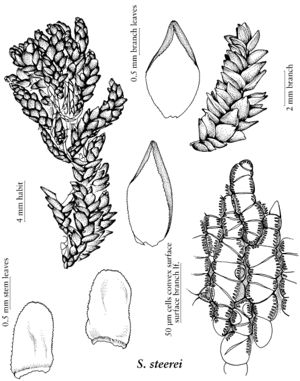Sphagnum steerei
Bryologist 90: 218. 1987,.
Plants moderate-sized to large, compact and stiff-stemmed with upswept branches; dark green and brown, dark chesnut brown, brown to blackish brown, often with bluish tinge when dry; forming dense low to moderately tall hummocks. Stems dark brown, superficial cortical layer with spiral reinforcing fibrils visible, usually 2 or more pores per cell, comb-fibrils lacking on interior wall. Stem leaves to 1.2 × 0.8 mm; rarely hemiisophyllous; hyaline cells mostly nonseptate, comb-lamellae usually absent, but sometimes weak. Branches short and blunt-tipped, leaves spreading. Branch fascicles with 2 spreading and 1 pendent branch. Branch stems with hyaline cells non-ornamented, no or weak funnel-like projections on the end walls of cortical cells, cortical cell walls usually with large round pores. Branch leaves ovate to ovate-elliptical, 1.6–2.2 × 1 mm; hyaline cells on proximal half of convex surface with round to elliptic pores along the commissures; comb-lamellae on hyaline cell wall where overlying chlorophyllous cells; chlorophyllous cells broadly triangular in transverse section and well-enclosed on convex surface, end wall not thickened. Sexual condition dioicous. Capsule unknown. Spores unknown.
Habitat: Commonly in firm-bottomed poor to medium fen vegetation, subarctic to arctic regions
Elevation: low to moderate elevations
Distribution

Man., N.W.T., Nunavut, Que., Yukon, Alaska, e Asia.
Discussion
Sphagnum steerei is usually easily recognized in the field by its dense growth habit and dark brown color. Its ecology is somewhat unclear due to taxonomic confusion with S. imbricatum in the strict sense and S. austinii (R. E. Andrus 1987). The latter is the only species in the imbricatum complex that occurs where S. steerei does. Contrary to the view of H. A. Crum (1997), S. steerei is quite distinct from S. affine and S. austinii. There is no range overlap with either of those species and the macroscopic appearance is also quite different.
Selected References
None.
